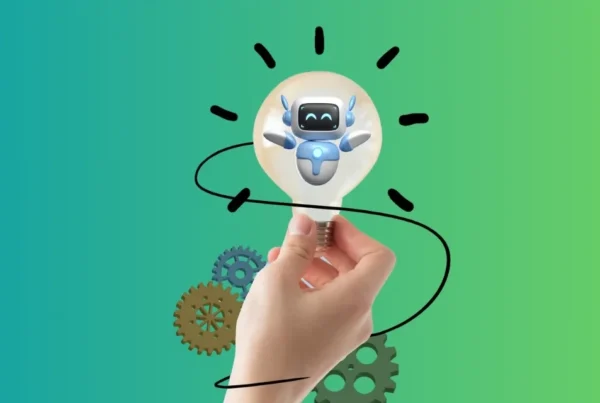
The modern era is an era of unprecedented convenience. Imagine any form of convenience, even an outrageous one, and there’s a high chance that someone is developing a product or service to deliver that convenience. This also means that customers expect more. 90% of customer service leaders state that customer expectations are at an all-time high. Against this backdrop, contact centers are playing a pivotal role in addressing consumers’ changing needs and expectations.
AI is reshaping communication dynamics as the demand for seamless interactions prompts a reevaluation of traditional customer service approaches. Intelligent automation is highly critical for the successful transformations in the contemporary CX landscape. The scope for improvement is highly widespread with robust self-service, seamless omnichannel outreach, people+AI customer service, streamlined workflows, updated knowledge bases, and efficiency on both agent and customer ends.
About 90% of customers rate immediate response to their support query as important or very important.
Changing Roles and Goals of Contact Centers in Customer-Centric Landscape
Approximately 40% of internet users indicate a preference for engaging with chatbots. This signals an increasing acceptance of AI in customer interactions. But acceptance doesn’t negate the need for good experience. Notably, negative service interactions have tangible consequences, with one-third of consumers discontinuing business relationships with brands after a negative experience. This can affect even the brands the customers are acquainted with.
Customers connect with brands at an emotional level. Therefore, the emotional impact of negative experiences is also significant, as evidenced by 12% of customers admitting that a poor service experience led to emotional distress. AI and intelligence automation innovations in contact centers have definite gains in resource optimization and operational efficiency. CX leaders are aiming to leverage their advantage to create more fulfilling experiences that connect at a human level.
AI-Driven Transformations in Contact Centers
An escalating demand for fast and 24/7 service availability, coupled with the growing emphasis on omnichannel support, has put automation in a critical position. The emotional toll of service interactions, where 26 percent of customers acknowledge losing patience, underscores the need for innovative automation. AI-driven contact centers are investing in powerful automation technologies as it is instrumental in streamlining customer journeys and ensuring accuracy in AI conversations. It is a critical factor, as 55 percent of customers stated that they prioritize swift answers while connecting with support.
Such transformations are revamping the CX landscape, using AI beyond efficiency goals, and catalyzing customer interactions and loyalty with business growth intent. It acts as the vital link between businesses and their clientele, ensuring that each interaction surpasses mere transactional exchanges, reinforcing strong customer relationships and commitment to excellence.
Key AI Integrations Nurturing CX Revolutions
Intelligent automation in contact centers is a strategic fusion of several AI and automation technologies that come together to offer a range of benefits. CX leaders are recognising how valuable good customer interactions can be, and therefore, they’re focusing on streamlining customer journeys. AI-enhanced Interactive Voice Response (IVR) systems, backed by Natural Language Processing (NLP), play a crucial role in directing users to the right information swiftly. This expedites issue resolution and contributes to a smoother customer experience.
Contrary to popular uproar, the integration of AI automation doesn’t seek to replace human agents but rather enhances their capabilities. Intelligent automation allows human agents to focus on more complex and value-added aspects of customer interactions by minimizing repetitive tasks. This, in turn, leads to improved overall efficiency, ensuring that customer concerns are addressed with precision and speed. It also improves the organization’s bottom line by optimizing resource utilization.
Building Self-Service Infrastructure
Effective self-service solutions, particularly those driven by AI, are key components in the evolution of contact centers. AI-driven chatbots, for instance, play a crucial role in providing faster issue resolution, contributing to a more efficient operational framework. Contrary to the notion of replacing human agents, these self-service solutions are designed to complement human efforts. Chatbots, smart IVRs, comprehensive knowledge bases such as FAQs, and video assistance are some of the most tried and tested self-service models.
The role of AI-driven chatbots goes beyond cost reduction and extends to enhancing the overall customer experience. They are more robust in terms of understanding customer queries and human language. By swiftly addressing customer queries and issues, these solutions contribute to customer satisfaction and loyalty. In doing so, they act as valuable support tools for human agents, allowing them to focus on more complex tasks that require a human touch.
Data-Driven Approach to Customer Service
A data-driven approach lies at the core of AI contact centers driven by intelligent automation. By harnessing data analysis, contact centers can achieve sophisticated routing and prioritization of customer queries. This ensures that customers are directed to the most appropriate channels and contributes to proactive issue resolution, addressing concerns before they escalate.
The impact of intelligent automation on cost reduction is significant. By automating repetitive tasks and optimizing workflows, contact centers can operate more efficiently, leading to reduced operational costs. Beyond cost savings, intelligent automation unlocks new growth opportunities. The streamlined processes and enhanced customer experiences create a foundation for business expansion and increased customer retention.
Adapting to changing customer expectations is a key driver in implementing intelligent automation. As customers increasingly seek personalized interactions, contact centers must evolve. AI facilitates this shift, allowing for tailored responses and services that align with individual preferences. This adaptability positions contact centers to not only meet but exceed customer expectations in an ever-changing landscape.
Intelligent Automation in Customer Service
Intelligent automation in customer service encompasses a range of inclusive technologies, including Artificial Intelligence (AI), Robotic Process Automation (RPA), and multi-cloud architecture. These technologies work in tandem to ensure quick response times, support across various channels, and error-free deliveries of services.
The role of generative AI is particularly noteworthy in transforming content and providing instant solutions. By leveraging generative AI models, contact centers can enhance the quality of responses, ensuring accuracy and relevance. This technology becomes a valuable asset in creating a seamless and efficient customer experience.
62% of customers wish to receive service at any time and on the channel that they primarily prefer.
The Blend of Predictive Analytics and Conversational AI
Swift issue resolution is a hallmark of the blend of predictive analytics and conversational AI in contact centers. AI-powered chatbots and virtual assistants contribute to immediate customer support by swiftly addressing queries and concerns. This enhances customer satisfaction and streamlines the workload for human agents, allowing them to focus on more complex tasks.
Omnichannel support is a key benefit derived from the integration of predictive analytics and conversational AI. These technologies enable contact centers to efficiently handle customer queries across various channels, providing a cohesive and integrated experience. The reduction of errors is another advantage, as AI-driven systems ensure consistency and accuracy in responses, contributing to effective personalization and building customer trust.
Leveraging predictive analytics is instrumental in achieving intelligent workflow automation in contact centers. Predictive routing ensures that customer queries are directed to the most appropriate agents or channels based on historical data and patterns. This not only expedites issue resolution but also enhances overall operational efficiency.
Prescriptive AI takes the predictive approach a step further by guiding decision-making in scenarios with multiple options. This is particularly relevant in customer-agent connections, where personalized recommendations and actions contribute to a more tailored customer experience. Insights derived from predictive AI techniques play a crucial role in resource planning, scheduling, and creating personalized engagement flows, allowing contact centers to adapt dynamically to evolving customer needs.
Conversational AI as a Core Capability
Conversational AI stands as a core capability in the modernization of contact centers. Its significance lies in enabling natural and controlled interactions between customers and brands through the integration of bots and virtual assistants. By facilitating seamless communication, conversational AI contributes to an improved customer experience. Combining predictive analytics and conversational AI further enhances this experience by providing personalized interactions and fostering improved relationships to boost brand loyalty.
Benefits of Automation in AI Contact Center
The benefits derived from contact center automation are multifaceted. One primary advantage is the assurance of efficient customer connections. When deployed effectively, automation optimizes operational efficiency by reducing response times and providing accurate and relevant information.
Continuous optimization is another significant aspect. Real-time analytics and insights generated by intelligent automation tools enable contact centers to adapt swiftly to changing trends and customer preferences. This proactive approach not only addresses current needs but also anticipates future requirements.
Generative AI, powered by intelligent automation, provides instant and clear explanations to agents. This not only aids in issue resolution but also enhances the overall customer and agent experiences. By leveraging generative AI, contact centers can ensure a seamless flow of information, contributing to more effective problem-solving and decision-making processes.
Usability and Usefulness of AI Solutions
In the realm of AI solutions, usability and usefulness are paramount. The effectiveness of these solutions is measured by their ability to accelerate processes without causing disruption to existing workflows. AI solutions should seamlessly integrate within the overall contact center infrastructure, ensuring a cohesive operation. Usability extends to providing visibility and control, allowing organizations to implement and manage AI solutions effectively. This approach ensures that the deployment of AI aligns with the objectives of the contact center, enhancing efficiency without introducing complexities.
Disciplines of AI in Contact Center Strategy
A strategic approach to AI in contact centers involves the integration of predictive, conversational, and generative AI disciplines. This comprehensive strategy drives innovation, efficiency, and smart automation in customer engagement. Predictive AI aids in anticipating customer needs, guiding decision-making, and optimizing workflows. Conversational AI ensures a natural and responsive interaction environment. Generative AI contributes to content transformation, providing instant and clear explanations. The synergy of these disciplines is key to achieving business goals in a customer-centric landscape.
Conclusion: How AI and Automation is Spearheading Contact Center Innovation
The transformative impact of intelligent automation on contact centers is evident. It goes beyond operational efficiency to redefine how organizations meet customer expectations. The ability to facilitate efficient workflows, provide personalized interactions, and integrate innovative AI solutions positions contact centers at the forefront of customer service excellence.
Meeting customer expectations is no longer a challenge but an opportunity, thanks to intelligent automation. The future of customer service lies in the continued evolution of contact centers. As technology advances and customer preferences evolve, contact centers must remain agile, adapting to the changing landscape. The integration of intelligent automation is not just a trend; it is a necessity in sustaining and elevating customer service standards. The journey toward the future involves a commitment to efficient, personalized interactions and the ongoing exploration of innovative AI solutions within contact centers.



